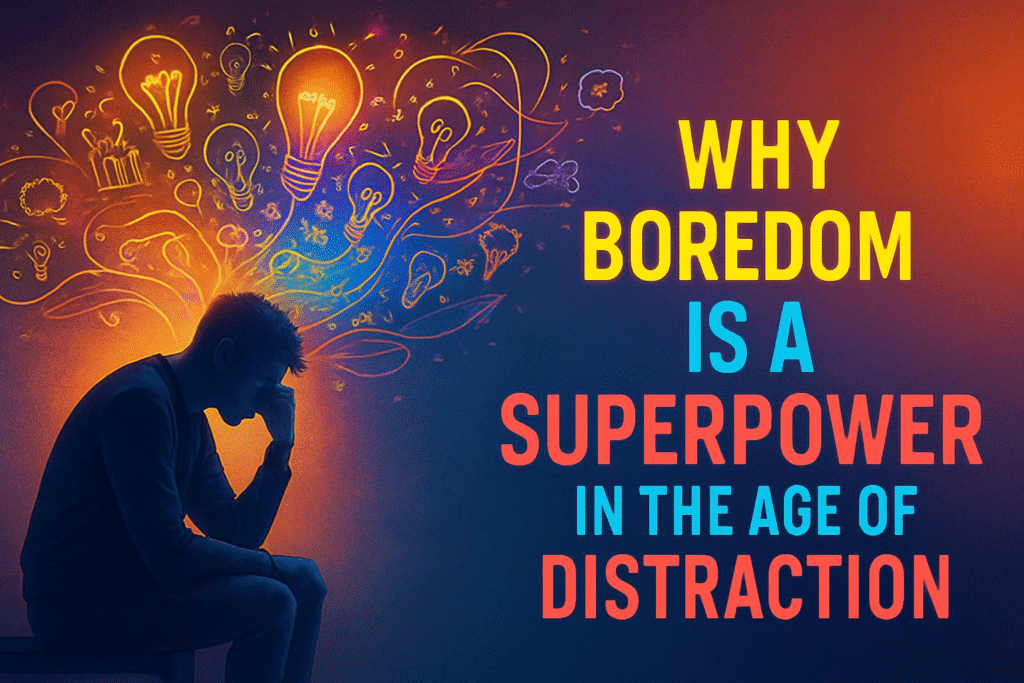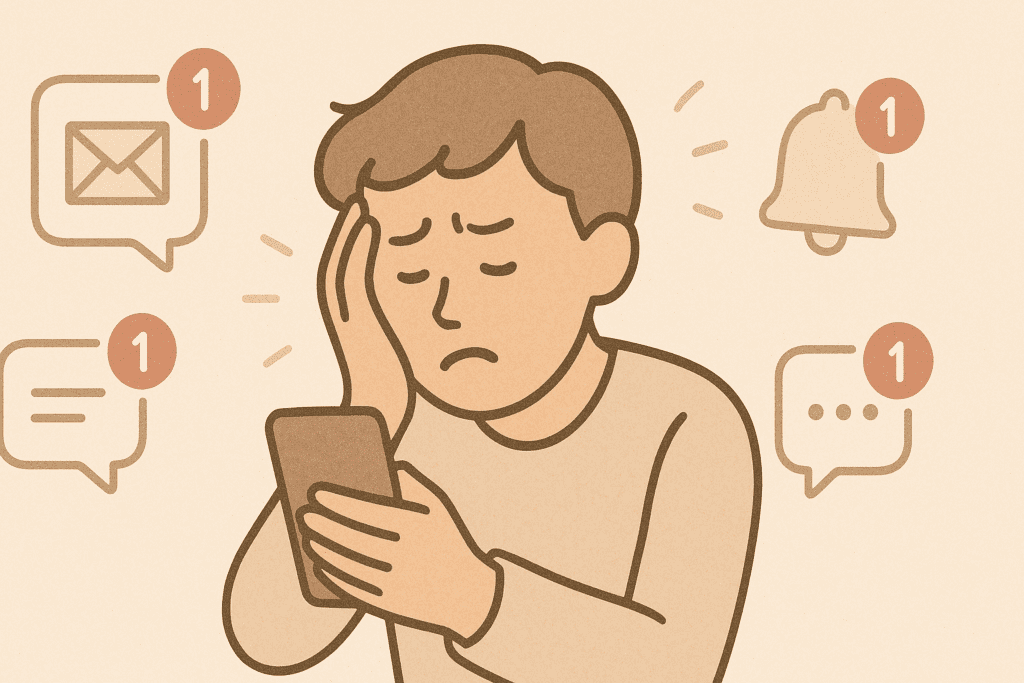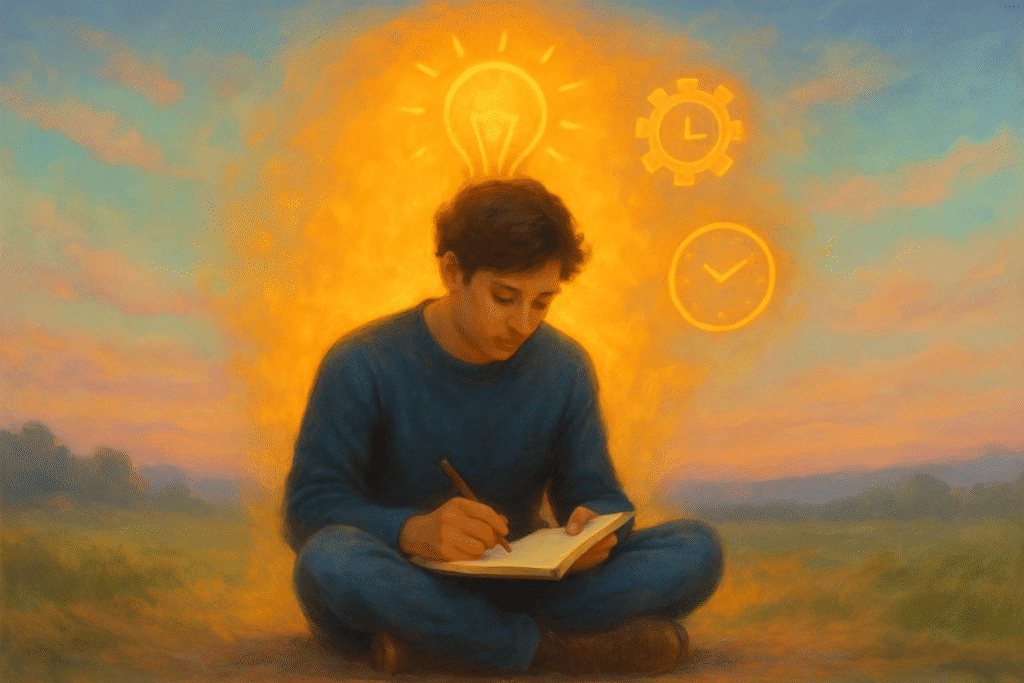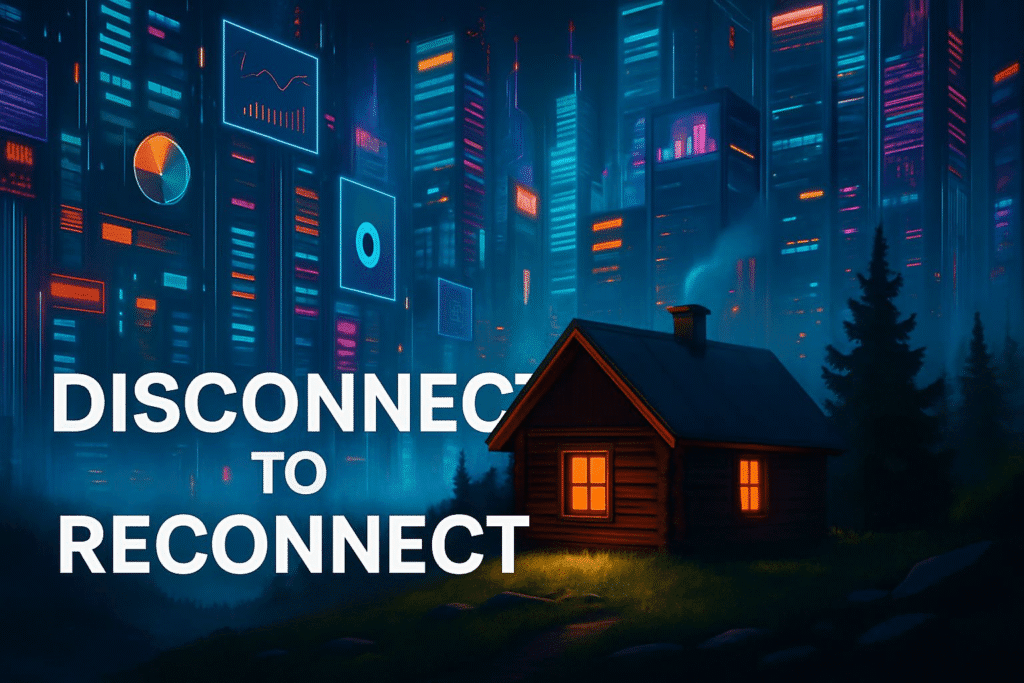Introduction

In an age where silence is quickly drowned out by the buzz of notifications and endless digital content, boredom has become something we actively avoid. We swipe, scroll, and stream to escape even a few seconds of stillness—without realizing what we’re losing in the process. But what if boredom isn’t a sign of laziness or lack of stimulation? What if it’s actually one of the most powerful tools we’ve been ignoring?
Recent studies suggest that boredom might not just be a fleeting feeling—it could be the mental reset button we all need. Far from being useless downtime, it might just be the spark behind some of our most creative and focused moments.
In this blog, we’ll dive into the surprising science behind boredom, explore how it affects your brain, and uncover how embracing those quiet moments can lead to breakthrough ideas and sharper thinking.
The Science Behind Boredom

We’ve been conditioned to think of boredom as a problem—something to cure with a tap, a swipe, or a scroll. But what if boredom isn’t the absence of stimulation, but the invitation your brain needs to do some of its best work?
1. Boredom and the Brain: Unlocking the Default Mode Network
When you’re staring out the window, waiting in line, or simply sitting in silence, your brain doesn’t shut down—it switches gears. Neuroscientists have discovered that in these quiet moments, the brain enters what’s known as the Default Mode Network (DMN)—a state deeply associated with introspection, imagination, and idea generation.
This neurological “background mode” is where seemingly random thoughts connect, long-term goals resurface, and fresh perspectives form. In other words, when your brain isn’t tied up in tasks, it begins solving problems in subtle, creative ways you’re often unaware of in the moment. It’s no coincidence that so many breakthrough ideas happen in the shower or during a walk—you’ve unknowingly entered this rich mental state.
2. The Surprising Psychological Benefits of Boredom
Beyond brain function, boredom serves a deeper emotional and psychological role. It acts like a mental mirror, reflecting back your desires, discontent, and direction in life. Left alone with your thoughts—even if uncomfortably so—you’re more likely to reassess your priorities, revisit forgotten passions, or reimagine your path forward.
Psychologists also note that regularly facing boredom without escaping it strengthens mental resilience. In a world where instant gratification is king, the ability to sit with discomfort—without immediately pacifying it—builds patience and emotional endurance. Even more interestingly, people who embrace boredom often develop richer social connections, simply because they’re more present and open to meaningful conversation when not numbed by screens.
3. The Danger of Constant Stimulation
If boredom is a tool, overstimulation is the thief that hides it.
Modern life offers us an endless stream of dopamine-triggering distractions. But while that might feel good in the moment, studies show it comes at a steep cost: reduced attention spans, shallow thinking, and cognitive fatigue. When you never give your brain a break, you rob it of the quiet space it needs to connect dots, process information deeply, or recover from mental load.
In fact, neuroscientists warn that perpetual digital engagement rewires the brain to expect novelty constantly—making it harder to focus, harder to reflect, and harder to truly think.
Boredom Isn’t a Bug in the System—It’s the Feature We Forgot
Instead of running from boredom, we should be leaning into it. It’s in those “empty” moments that your brain recharges, rethinks, and reinvents. In a world obsessed with doing more, maybe the smartest thing you can do… is pause.
Why Boredom Sparks Creativity
We often treat boredom like a productivity killer—something to avoid at all costs. But what if those quiet, uncomfortable moments are actually fertile ground for your most brilliant thoughts? Emerging research and historical anecdotes suggest that boredom doesn’t block creativity—it activates it.
1. From Boredom to Breakthrough: Why Innovation Needs Silence
Have you ever noticed that your best ideas rarely come when you’re staring at a screen? That’s because when the brain isn’t locked onto external stimuli, it naturally turns inward. In this mental “idle mode,” the mind begins to explore, question, and imagine. Neuroscientists call this the activation of the Default Mode Network (DMN)—a system in your brain associated with autobiographical memory, future planning, and creative thought.
Boredom, it turns out, is a nudge toward exploration. It sparks curiosity, prompting you to fill the mental void with new concepts, questions, and possibilities. Some of the world’s most celebrated innovators—like Albert Einstein, who claimed to have developed his theories while quietly pondering nature, or Steve Jobs, who regularly emphasized the value of boredom—used idle time as a tool, not a threat.
2. Daydreaming: The Playground of the Imagination
Letting your mind wander is often discouraged in traditional productivity culture, but science tells us it’s where the magic happens. Daydreaming, a natural byproduct of boredom, allows your thoughts to leap beyond the obvious and into abstract or imaginative territory.
Research has linked daydreaming with higher problem-solving ability, emotional insight, and artistic creativity. It’s not just idle chatter in your brain—it’s structured mental exploration. From novels and inventions to revolutionary theories, many human achievements can trace their origins back to a moment when someone “wasn’t paying attention.”
3. The Cost of Constant Distraction
Today, we rarely give our minds the space to wander. Notifications, emails, videos, and social media feed a cycle of constant engagement. While it may feel productive or entertaining, this overstimulation crowds out deep, original thinking.
Without moments of silence and stillness, your brain doesn’t get the downtime it needs to form new ideas or refine old ones. Creativity suffers. Instead of profound insights, we get surface-level solutions. Instead of breakthroughs, we settle for distractions.
By embracing boredom, you’re not being lazy—you’re giving your mind room to breathe, reset, and reconnect with its creative core.
Creativity Lives in the Gaps
If you want to innovate, think differently, or simply reconnect with your own thoughts, boredom isn’t the enemy—it’s the doorway. Step through it, and you might just discover something extraordinary waiting on the other side.
The Negative Effects of Constant Stimulation

In a world where every moment can be filled with noise—be it from buzzing phones, endless video streams, or algorithm-curated feeds—true stillness has become a rare experience. While instant access to information has empowered us in many ways, the unintended side effect is a mental environment overloaded with input and starving for reflection.
1. The Cognitive Toll of Overstimulation
Your brain is brilliantly designed for focus, but it wasn’t built to process a flood of notifications, pop-ups, and back-to-back content 24/7. This relentless input causes what scientists call cognitive overload—a state where the brain struggles to sort, prioritize, or retain information.
Neuroscience research shows that this constant mental juggling act erodes our ability to concentrate and solve complex problems. Instead of working deeply, we skim. Instead of thinking critically, we bounce from distraction to distraction. Over time, the result is more than just fatigue—it’s a brain that’s wired for noise and starved of clarity.
Even more concerning? This overstimulation can contribute to heightened anxiety and stress, as the brain fights to sift signal from noise in an environment where everything competes for attention.
2. The Dopamine Feedback Loop: Why Distraction Feels Addictive
Every ping, like, or new post delivers a micro-dose of dopamine—a chemical associated with pleasure and reward. This biological response creates a feedback loop where the brain begins to crave constant engagement, regardless of whether it’s meaningful.
Boredom, by contrast, starts to feel unbearable—not because it’s harmful, but because the brain has grown so accustomed to instant gratification. Unfortunately, this rewiring reduces your capacity for patience, self-regulation, and most importantly, deep thought.
We become addicted to stimulation, not because it’s valuable, but because it’s easy.
3. How Overstimulation Stifles Creativity and Focus
When your brain is always “on,” it never has the chance to connect dots or reflect on the bigger picture. This is especially harmful to creativity, which relies not on nonstop input but on mental spaciousness—those gaps where insight often blooms.
Studies suggest that moments of mental rest (yes, even boredom) allow your mind to form novel connections and produce meaningful ideas. In contrast, overstimulation forces the mind into a reactive mode, where thoughts are fragmented and problem-solving becomes shallow.
Creativity, like a seed, doesn’t grow under floodlights. It needs quiet, undistracted soil.
4. Reclaiming Mental Space: How to Unplug and Recenter
Escaping this cycle doesn’t require a digital retreat to the mountains—but it does require intention. Here’s how you can start reclaiming your attention and reawakening deeper mental function:
- Limit passive screen time: Choose content with purpose, and build screen-free windows into your daily routine.
- Practice digital mindfulness: Use tools like “Do Not Disturb” modes or app timers to regain control over your attention.
- Replace scrolling with stillness: Journaling, meditating, or even a quiet walk without headphones can bring clarity you didn’t know you were missing.
The goal isn’t to eliminate technology—it’s to rebalance your relationship with it.
Boredom as Mental Nutrition
What feels like “doing nothing” is often exactly what your brain needs to reset, reflect, and rewire. Constant stimulation might feel productive, but over time it erodes the very qualities—focus, creativity, and resilience—that true productivity depends on.
By learning to sit with boredom, even just for a few minutes a day, you create the mental conditions for your best work, deepest thoughts, and most powerful insights.
How to Harness Boredom for Productivity

What if the very feeling we avoid the most—boredom—is actually the signal we’ve been waiting for? In a culture obsessed with stimulation and speed, boredom can feel like wasted time. But when used intentionally, it becomes a powerful driver of focus, creativity, and breakthrough thinking.
Here’s how to shift your mindset and make boredom work for you:
1. See Boredom Differently: A Hidden Doorway to Insight
Most of us treat boredom as a red flag—something to fix, distract from, or escape. But what if we saw it as an opportunity? Instead of asking, “How do I kill time?” try asking, “What can I learn or imagine right now?”
Boredom isn’t an enemy—it’s an invitation. It nudges us to step away from autopilot behaviors and reconnect with deeper, more meaningful pursuits.
2. Reflect with Intention: Use Boredom to Think Clearly
Rather than reaching for your phone the moment boredom hits, lean into the silence. Try journaling, even briefly. Writing down your thoughts during these moments often reveals patterns, ideas, or questions you hadn’t consciously considered.
Alternatively, practicing mindfulness—even for five minutes—can help your brain reset, process lingering thoughts, and make space for clarity.
3. Create Space: Reduce the Noise That Crowds Your Mind
If boredom is the seed of insight, overstimulation is the weed that chokes it. Take control of your digital environment by:
- Setting limits on apps and notifications.
- Creating “no-screen” time blocks during your day.
- Turning off background noise when engaging in important tasks.
By reducing digital friction, you create room for the kind of thought that leads to innovation.
4. Make Room for Creative Play
Give your brain the freedom to wander. Unstructured boredom has been linked to unexpected insights—the kind that often emerge when you’re doodling, scribbling thoughts, or just staring at the ceiling.
Try low-pressure, open-ended activities like:
- Free writing or mind mapping
- Sketching with no outcome in mind
- Brainstorming ideas without judgment
These practices spark the kind of non-linear thinking where creativity thrives.
5. Schedule Boredom: Yes, Really
This may sound counterintuitive, but setting aside intentional time to “do nothing” is one of the most productive things you can do. When you disconnect from the noise, your brain finally gets a chance to connect the dots—between ideas, goals, and possibilities.
Even a 10-minute window of stillness can enhance your problem-solving skills, boost focus, and lead to a creative breakthrough you didn’t see coming.
Stillness Isn’t a Pause—It’s a Launchpad
Boredom is not a defect in our attention. It’s a gateway to presence, originality, and deeper thought. By learning to embrace it—rather than numb it—we reclaim a rare mental space where creativity, clarity, and innovation naturally emerge.
The next time boredom knocks, don’t shut the door. Open it—and let your mind explore what’s on the other side.
The Future of Boredom in a Hyperconnected World

As technology becomes more immersive, personalized, and ever-present, moments of stillness are vanishing. We’re entering an era where boredom is not just inconvenient—it’s nearly extinct. But what if that very extinction makes boredom one of the most valuable mental states of the future?
1. The Vanishing Act: Boredom in the Age of Algorithms
Every idle second is now accounted for. Whether you’re standing in line or lying in bed, algorithms are ready to entertain, inform, and distract—customized perfectly to your preferences. Streaming platforms auto-play the next episode. Social media never sleeps. AI curates content to keep you scrolling endlessly.
In this environment, boredom isn’t just rare—it’s often treated as a failure of design. And yet, the absence of boredom might be costing us more than we realize.
2. Why Boredom Will Become a Competitive Edge
As the world moves faster and becomes more digitally saturated, the ability to disengage—to sit in silence, reflect, and think deeply—will become a rare and highly valuable skill.
In a marketplace flooded with constant content, those who can pull away from noise and think clearly will be the ones who innovate. Future-forward companies and creators won’t just optimize engagement—they’ll protect space for mental spaciousness.
The next generation of leaders won’t just be great multitaskers—they’ll be master focusers, people who can dive deep, think originally, and resist the seduction of endless distraction.
3. Mindfulness as Rebellion: Why Digital Detox Is Rising
The rise of digital detoxes, silent retreats, and minimal-tech lifestyles isn’t a passing trend—it’s a cultural correction. More people are waking up to the cognitive and emotional costs of always being plugged in.
Whether it’s a tech-free Sunday, a silent morning routine, or mindful breaks throughout the workday, professionals and students alike are finding that boredom isn’t a void—it’s a vital reset point for the mind.
Forward-thinking schools, startups, and even some corporate environments are experimenting with boredom-boosting practices to encourage reflection and creativity rather than nonstop input.
4. Preparing for a Future That Won’t Wait
If we want to preserve our ability to think independently in a world designed to think for us, we need to reclaim boredom intentionally. That means:
- Scheduling stillness as part of your daily routine.
- Setting digital boundaries before the algorithms set them for you.
- Practicing boredom not as avoidance, but as mental training—like a gym for your focus and imagination.
In a society that thrives on grabbing your attention, protecting your inner space will become both a personal advantage and a revolutionary act.
Boredom Is the Future’s Secret Weapon
As hyperconnectivity becomes the norm, the ability to disconnect may define who creates, who leads, and who thrives. In a noisy world, stillness becomes strategy. Those who learn to embrace boredom now will be the ones shaping the ideas, art, and innovation of tomorrow.
Conclusion
In a world flooded with endless notifications, entertainment, and distractions, boredom has become a rarity—and often something to avoid. Yet, rather than being a flaw or weakness, boredom is actually a superpower waiting to be tapped into.
When we allow ourselves to embrace boredom, our minds shift into a state of reflection, creativity, and problem-solving. The default mode network in our brains gets activated, facilitating deeper thought and unexpected breakthroughs. It’s in these quiet moments that we can solve complex problems, generate new ideas, and tap into the very creativity that powers innovation.
As society continues to race toward hyperconnectivity, the ability to disconnect, step away from constant stimulation, and embrace boredom will become a competitive edge—one that fuels creativity, sharpens focus, and drives innovation. In a world that never stops, the art of stillness may be your most powerful tool for success.
Are you ready to unlock the potential of boredom? The next time you find yourself bored, remember—it’s not a moment to fill, but a moment to grow.
Amazon Books Recommendation Section
These books explore themes related to boredom, creativity, and focus in a distracted world:
1. The Power of Boredom: Why Boredom is Essential for Creating a Meaningful Life
- Author: Mark A. Hawkins
- Why It’s Recommended: Explores how boredom can be a catalyst for creativity, self-reflection, and personal growth.
- Find it on Amazon: Here
2. Digital Minimalism: Choosing a Focused Life in a Noisy World
- Author: Cal Newport
- Why It’s Recommended: Discusses how reducing digital distractions can enhance focus and creativity.
- Find it on Amazon: Here
3. Bored and Brilliant: How Spacing Out Can Unlock Your Most Productive and Creative Self
- Author: Manoush Zomorodi
- Why It’s Recommended: Explores how embracing boredom can lead to breakthroughs in creativity and productivity.
- Find it on Amazon: Here
4. Indistractable: How to Control Your Attention and Choose Your Life
- Author: Nir Eyal
- Why It’s Recommended: Provides strategies to overcome distractions and regain control over focus and deep thinking.
- Find it on Amazon: Here
These books provide valuable insights into historical wealth, royal fortunes, and economic influence.
FAQ’s
Why is boredom considered a superpower?
Boredom allows the brain to reset, reflect, and generate creative ideas, making it a powerful tool for innovation and problem-solving.
How does boredom enhance creativity?
Studies show that when people experience boredom, their minds wander, leading to new connections, insights, and creative breakthroughs.
What are the negative effects of constant digital stimulation
Excessive stimulation can lead to mental fatigue, reduced attention span, and difficulty focusing on deep work
How can I embrace boredom instead of avoiding it?
Practicing mindful reflection, journaling, and taking breaks from technology can help harness boredom for productivity and creativity.
Will boredom become more valuable in the future?
As society becomes more digitally connected, the ability to disconnect and embrace boredom will be a competitive advantage for deep thinking and innovation.
